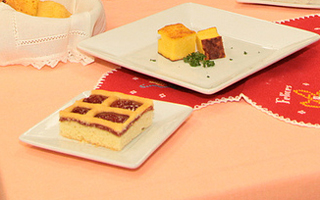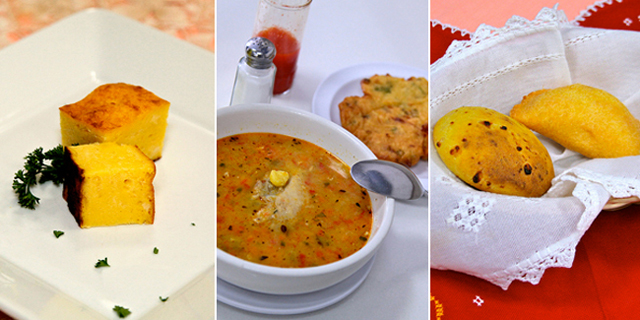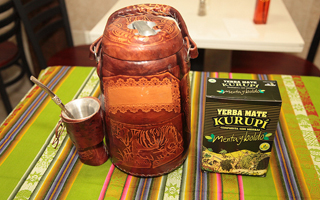If you love Latin food, it’s easy to become afflicted with the same syndrome that can infect any aficionado: the smugness of thinking you’ve seen, or in this case, eaten everything. The joy of discovery is replaced by the twin joys of knowing so much and eating the most extraordinary version of your favorite dish (preferably in an obscure, off-the-beaten-path place or by a chef with Michelin stars). And then, suddenly, you find yourself eating a generous serving of humble pie.
Related: Brazilian Food 101: A Pocket Guide to Brazil’s Best Bites
This is what happened to me a couple weeks ago when my husband suggested we take a trip to Sunnyside, Queens to try Paraguayan food at New York City’s first, and until recently, only, Paraguayan restaurant, I Love PY. We arrived on a Saturday afternoon and jockeyed with Paraguayan expats for a couple spots at a table in the small storefront. As we waited for menus, we talked about what we knew of Paraguay. It wasn’t much.
Then the menus came and we really realized how little we knew of one of South America’s most obscure countries. Francisco, always devoted to caldos and asopados, decided he wanted sopa paraguaya; we ordered tortilla as a side and decided to try a few small plates whose names weren’t translated but were listed under a menu section titled “Tradicionales de Paraguay.” [pagebreak]
Owner Nancy Ojeda, who opened I Love PY with her husband seven years ago, brought our drinks and cutlery, but as Francisco pointed out, the soup spoon was missing. “Wait,” she said, a mischievous smile playing on her lips. Minutes later she was at the table with his sopa paraguaya, served on a plate, not in a bowl. It turns out that sopa paraguaya isn’t a soup at all. In her award-winning pan-Latin cookbook, Gran Cocina Latina, Maricel Presilla describes the dish accurately as “Paraguayan corn bread.” And Paraguayan tortilla is neither a corn or flour disc nor the omelette-like egg dish the Spanish refer to as “tortilla,” but rather a deep fried fritter.
We still had a lot to learn.
If Paraguayan food is new culinary territory for you, here’s a primer to the country’s most typical dishes, just in time for Paraguayan Independence Day, which will be celebrated on May 14. You can try these and other dishes at one of New York’s two Paraguayan restaurants, the more traditional I Love PY in Sunnyside or the fusion-focused Dela Mora, which opened just this year and is located in Jackson Heights. [pagebreak ]
Sopa Paraguaya
Not actually a soup, sopa paraguaya (shown at the top, left) is Paraguayan cornbread that contains two of the country’s most commonly used ingredients: eggs and corn. Though it’s a humble dish, it’s one you’re as likely to find at a wedding as you are at the family dinner table, says I Love PY’s chef, Julieta Soledad Vera. In fact, in addition to individual servings, the restaurant sells medium and large trays of sopa to paisanos who are celebrating a special occasion; orders are already coming in for upcoming Independence Day.
Tereré
Another familiar sight at many Paraguayan tables is the gourd and bombilla used to drink mate, also popular in Argentina and Uruguay. I Love PY owner Nancy Ojeda explains that mate is more commonly served cold in Paraguay, given the country’s extreme heat. Called tereré in Paraguay, the mate is less commonly drunk from a gourd than from a metal cup, which helps retain the drink’s refreshing coolness. If you prefer the hot version, ask for cocido, which is mate served with caramelized sugar. Many Paraguayan expats and former Peace Corps volunteers who served in the country meet regularly at I Love PY to chat and practice their Guaraní (Paraguay’s indigenous language, spoken by most Paraguayans) over cups of tereré.
Vori-Vori
Though rice is not a common accompaniment to soups and guisados in Paraguay, as it is in many other Latin American countries, corn flour is often found playing its thickening, absorbing role. Vori-vori (shown at the top, center), Paraguayan chicken soup, is an excellent example; in addition to chicken in a rich tomato-based broth, marble-sized balls of corn flour and cheese are added to the soup for heft. Here, the vori-vori is also accompanied by a Paraguayan tortilla, a fritter-like creation best eaten hot.
[ pagebreak ]Chipa So’o
Chipa so’o (shown at the top, right) is one of Paraguay’s many chipas, which cookbook author and chef Maricel Presilla describes as “the crumbly unleavened rolls…that serve as bread” throughout Paraguay. Presilla says there are dozens of types of chipas, some stuffed with meat, as this one is. I Love PY sells two other types of chipas (guazu and almidon) as well. The ingredient that all chipas have in common? Queso paraguay, which can be substituted with muenster or fontina, according to Presilla. Also in the basket is a beef empanada. Paraguayan empanadas typically have an egg inside, which prevents the snack from drying out.
Desserts

Along with her husband and son, Nancy Ojeda has been serving up Paraguayan favorites at I Love PY in New York for the past seven years. She is proud to share traditional dishes with her fellow expats, as well as other Latinos and non-Latinos who are curious about the country’s cuisine. “We don’t serve anything that’s not Paraguayan,” she says.
If you’re in New York City and want to taste Paraguayan food for yourself, you can do so at I Love PY or at Dela Mora.



![Making Mealtime Matter with La Familia: Easy Sofrito [Video]](https://thelatinkitchen.com/wp-content/uploads/2015/10/sofrito-shutterstock__0-500x383.jpg)
![Easy Latin Smoothies: Goji Berry Smoothie [Video]](https://thelatinkitchen.com/wp-content/uploads/2015/12/goji_berry-shutterstock_-500x383.jpg)
















![Fun and Fast Recipes: Fiesta Cabbage Salad [Video]](https://thelatinkitchen.com/wp-content/uploads/2015/11/fiesta_cabbage_slaw-shutterstock_-500x383.jpg)









